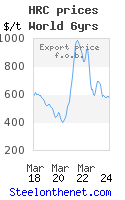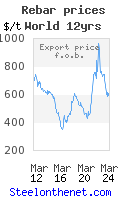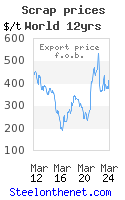The Russian steel industry since 2000 - lessons for the Ukraine?
Readers who are interested in the steel sector in the former Soviet bloc may find two articles from Kommersant of especial interest. The first, which reviews the history of Russian metallurgy over the period 2000-2004, describes in some detail the changing structure of the Russian metals sector from the beginning of the Putin era in ~2000.
The review starts with the aluminium sector (describing the consolidation of the asset base, and the creation by Abramovich of the new big groups such as Rusal). It then describes the developments in steel (the initial survival-driven focus on investment; the later creation of the new big steel groups such as Evraz Holding, a phase itself then followed by steel sector acquisitions elsewhere in Eastern Europe e.g. Romania, Croatia ... [blogger: maybe Turkey soon?]). The article also reminds readers that consolidation in Russian carbon steel was mirrored by parallel developments in the Russian steel pipe sector (the creation of TMK from Seversky, Sinarsky, Volzhsky and Taganrog, as a battle to survive against competition from the other steel pipe giant OMK).
According to Kommersant, the 2000-2004 period - characterised by these industry megadeals - was a period of Putin's rule during which (whether deliberately or not) the State adopted an essentially hands-off stance towards the steel sector. Kommersant suggest that it was this hands-off policy which allowed (forced?) consolidation to naturally take its course and to foster the emergence of the thriving steel sector that we now see in Russia today.
In a second article, referring to progress in the privatisation of the Ukrainian steel sector over the period 2000-2004, Kommersant note the almost identical predicaments of the Russian and Ukrainian steel industries at the turn of the decade, but comment on the interventionist policies of the Ukrainian government towards their steel sector on trade, taxation etc in the years that followed. Kommersant observe that, however they may have come about, non-intervention and successful evolution of the Russian steelmaking sector clearly do contrast with the interventionist background and uncertain evolution seen in the Ukraine. Whilst Kommersant do not see Government policies in the Ukraine as especially encouraging across the near-term, they do take heart from the observation that at least it is the Russian steel sector that is now in a position to acquire the steelmaking assets in the Ukraine, and not the other way round.
I strongly recommend both original articles to anyone interested in Soviet steel as an exceptionally good read!
blogger@steelonthenet.com
The review starts with the aluminium sector (describing the consolidation of the asset base, and the creation by Abramovich of the new big groups such as Rusal). It then describes the developments in steel (the initial survival-driven focus on investment; the later creation of the new big steel groups such as Evraz Holding, a phase itself then followed by steel sector acquisitions elsewhere in Eastern Europe e.g. Romania, Croatia ... [blogger: maybe Turkey soon?]). The article also reminds readers that consolidation in Russian carbon steel was mirrored by parallel developments in the Russian steel pipe sector (the creation of TMK from Seversky, Sinarsky, Volzhsky and Taganrog, as a battle to survive against competition from the other steel pipe giant OMK).
According to Kommersant, the 2000-2004 period - characterised by these industry megadeals - was a period of Putin's rule during which (whether deliberately or not) the State adopted an essentially hands-off stance towards the steel sector. Kommersant suggest that it was this hands-off policy which allowed (forced?) consolidation to naturally take its course and to foster the emergence of the thriving steel sector that we now see in Russia today.
In a second article, referring to progress in the privatisation of the Ukrainian steel sector over the period 2000-2004, Kommersant note the almost identical predicaments of the Russian and Ukrainian steel industries at the turn of the decade, but comment on the interventionist policies of the Ukrainian government towards their steel sector on trade, taxation etc in the years that followed. Kommersant observe that, however they may have come about, non-intervention and successful evolution of the Russian steelmaking sector clearly do contrast with the interventionist background and uncertain evolution seen in the Ukraine. Whilst Kommersant do not see Government policies in the Ukraine as especially encouraging across the near-term, they do take heart from the observation that at least it is the Russian steel sector that is now in a position to acquire the steelmaking assets in the Ukraine, and not the other way round.
I strongly recommend both original articles to anyone interested in Soviet steel as an exceptionally good read!
blogger@steelonthenet.com




0 Comments:
Post a Comment
<< Home